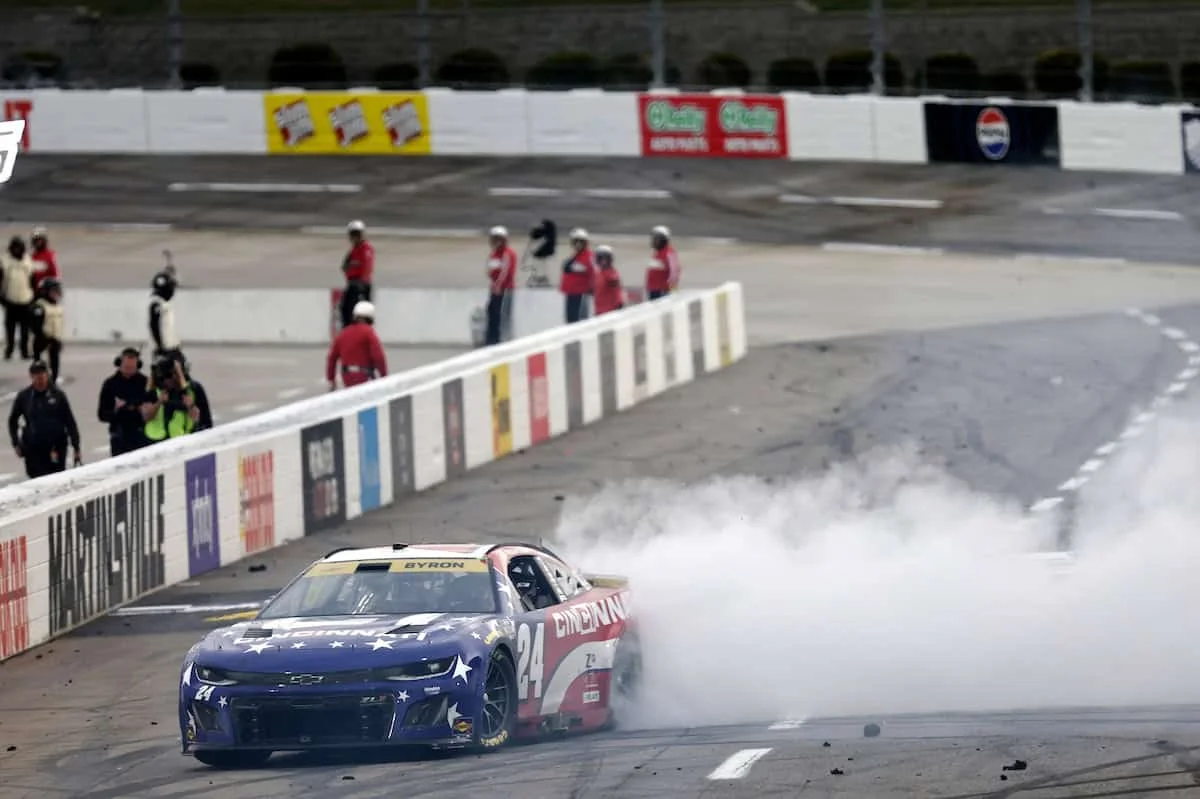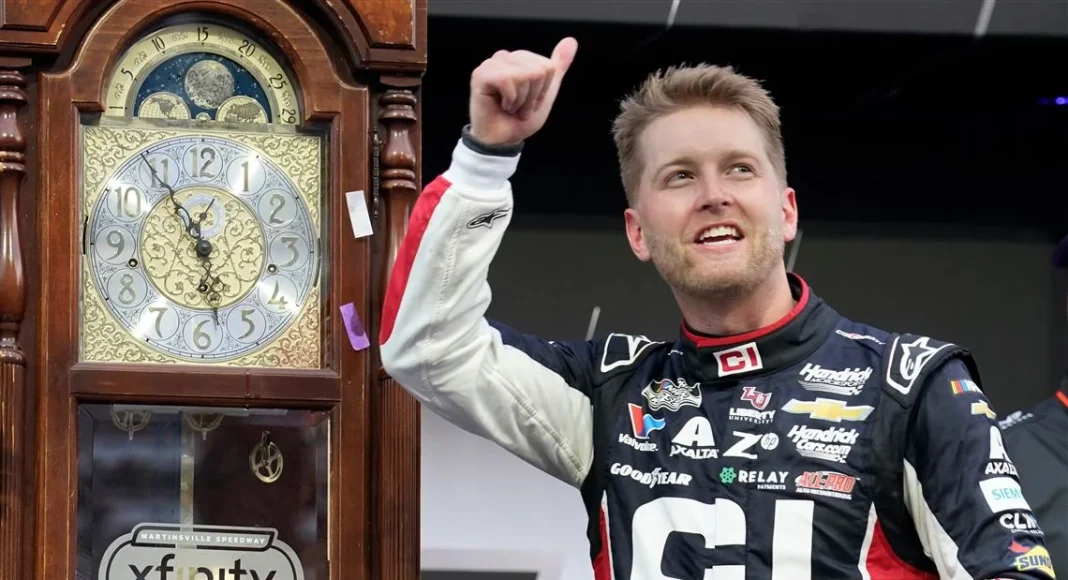William Byron secured his place in NASCAR‘s Championship 4 with a crucial victory at Martinsville Speedway on October 26, 2025, in a race defined by high stakes and fierce competition. Seeking to advance to the Phoenix Raceway finale, Byron needed a win to move on, showcasing the intensity surrounding the William Byron Martinsville victory.
Byron started the weekend strong by winning the pole, entering the event knowing only a first-place finish would virtually guarantee him a spot in the final round. Inspired by previous must-win scenarios pulled off by Ryan Blaney, Byron stayed focused under immense pressure. As the race unfolded, the battle for the championship slot narrowed between Byron, starting at the front, and Blaney, who charged from the 31st position.
“William Byron moves Ryan Blaney for the race lead!Both need a win to make the Championship race in Phoenix next week!pic.twitter.com/PQ8iS18phR”— Always Race Day (@AlwaysRaceDay)
Tension peaked as Blaney used pit strategy to surge forward during the final stage. Byron, however, maneuvered past Blaney with a decisive move on lap 457, using the bumper to edge ahead. Holding his lead on the late restart, Byron claimed the Xfinity 500 by a margin of .717 seconds over Blaney, ensuring his advancement to NASCAR’s final showdown.
“WE’RE GOING TO PHOENIX!!! #Championship4 🏁🍾 pic.twitter.com/rptPHcITiX”— William Byron (@WilliamByron)
Byron’s performance was dominant, leading a race-high 304 laps. This marked his third victory in the 2025 season and the 16th of his Cup career. The win earned him a third consecutive appearance in the Championship 4 finale, where he will compete against teammate Kyle Larson, along with Denny Hamlin and Chase Briscoe, as the playoff field is set.

This year’s finale will feature drivers from only two organizations: Hendrick Motorsports and Joe Gibbs Racing. The deep rivalry sets up a story-filled conclusion at Phoenix Raceway, as the pursuit of the NASCAR Cup comes down to a winner-take-all event.
High Stakes and Mechanical Failures Impact Playoff Landscape
While Byron secured his spot, the race saw a notable number of engine failures—an unusual occurrence in recent Cup Series seasons. Three competitors suffered engine trouble on Sunday, including major playoff contenders. Briscoe and Hamlin, both representing Joe Gibbs Racing, were forced out after their engines expired before the race’s end, and Toyota driver Riley Herbst faced the same fate.
The possibility exists that Briscoe and Hamlin were testing setups with little left to risk, having already qualified for the Phoenix finale. The gamble made sense from a strategic standpoint: if any new approach proved advantageous, it could offer a significant edge in the championship race. Ultimately, both missed their chance for a Martinsville win, but with their positions secure, the risk was minimal.
Nonetheless, for Denny Hamlin, the mechanical issue followed a string of lackluster performances, marking his second finish outside the top 20, threatening his momentum as the championship battle approaches. Hamlin’s past struggles in high-pressure title hunts raise concerns about his ability to clinch an elusive championship as attention shifts to Phoenix.
Points Standings Reset Ahead of Phoenix Showdown
With the conclusion of Martinsville, the four drivers heading to Phoenix—William Byron, Kyle Larson, Denny Hamlin, and Chase Briscoe—enter the final week with a clean slate. The championship will be decided entirely by their performance in the season’s last race, amplifying the winner-take-all format that heightens the stakes for everyone involved.
Aside from the championship, other points positions remain up for grabs. Christopher Bell and Ryan Blaney are positioned firmly in fifth and sixth, but seventh is closely contested among Tyler Reddick, Joey Logano, and Chase Elliott, who remain within a narrow 16-point margin. Reddick holds a slight advantage entering Phoenix, but the final order will be determined in the season closer.
Bubba Wallace is also in contention to close the year with his first top-10 standings finish. He heads into the last event in 10th place, twelve points clear of Ross Chastain. Chastain will press hard to overtake Wallace, ensuring a competitive battle through the final laps at Phoenix.
Blaney Rallies from the Back; Surprises and Standout Performances
Ryan Blaney delivered the day’s most impressive charge through the field. Starting 31st—a position that often spells trouble at Martinsville—Blaney surged into the top 10 by the end of the first stage and went on to lead 177 laps before narrowly missing victory. Despite being denied a third consecutive Martinsville win in the fall, his drive demonstrated resilience and skill, serving as a testament to his playoff credentials.
Josh Berry mirrored this accomplishment, starting 27th, overcoming two on-track incidents, and still recording a 10th-place finish. While Shane van Gisbergen didn’t claim a top-10 result, his 14th-place run stands out as evidence of rapid progress on NASCAR ovals. In contrast to his earlier struggles, including a 34th-place result six laps down in the spring event, van Gisbergen’s adaptability signals potential as a stronger playoff contender in 2026.
“P14 today for the 88 @SafetyCultureHQ team! Had a fun race running around 8-12th most of the day but just slipped back a bit at the end. Looking forward to finishing strong in Phoenix next weekend 👍 pic.twitter.com/qkYXwclXX5″— Shane van Gisbergen (@shanevg97)
Key Moments: Aggression at the Front Defines Martinsville
The decisive moment came when Byron used a textbook bump-and-run to overtake Blaney without causing deliberate contact or a crash. The move was assertive but within accepted norms at Martinsville, making a clear declaration of the style Byron is willing to employ in pursuit of the championship. This tactic, aggressive but not malicious, sets a tone that his competitors will note as they approach the title race at Phoenix.
Martinsville offered further illustration of the respect and reciprocity that govern driver interactions. Carson Hocevar, known for his aggressive style, faced stern racing throughout the event, as others mirrored the intensity he’s displayed to them throughout the season. Hocevar’s experience serves as a stark reminder: drivers often race others as they’ve been raced themselves, and the consequences became evident as he battled hard for track position but wasn’t given any concessions.
What Awaits in Phoenix and Why Fans Should Tune In
The NASCAR season finale at Phoenix Raceway promises drama, with the four championship contenders set for a clean points reset and a single-race shootout. Notably, the last time one of this year’s finalists, William Byron, won at Phoenix was in the spring of 2023. Hamlin is the only driver among the title contenders with multiple Phoenix victories, but his last came in 2019. Kyle Larson and Chase Briscoe also have Phoenix wins to their names, giving each finalist a reason for optimism but no clear favorite.
Byron carries momentum into the finale on account of his Martinsville success, while both Hamlin and Briscoe must overcome recent engine failures to assert themselves. Outside the playoff bubble, Christopher Bell has won two of the last three events at Phoenix, hinting at possible surprises, and Joey Logano has more Phoenix wins than any other active driver, offering further intrigue for fans.
Beyond the Cup Series, attention is fixed on NASCAR’s post-race penalty report following controversial actions in the Xfinity Series. Sam Mayer, reacting to contact from Jeb Burton, deliberately hooked Burton during the cool-down lap, prompting a hard crash. Mayer admitted his intent post-race, leaving open the prospect of a suspension for the final round in Daytona—a significant development as competitive tensions remain high across all levels of NASCAR competition.
Analysis of the Racing and the Next Gen Car
The Martinsville event brought to light mixed reactions concerning the current state of racing and the impact of the Next Gen car. While NASCAR introduced a tire designed for greater wear and increased strategic variability, the resulting fall-off failed to significantly alter the battle for the lead. Most of the day’s action unfolded within the pack, with Byron’s late-race nudge to Blaney providing the main singular front-running highlight.
Persistent challenges with the Next Gen car at short tracks such as Martinsville have left fans wanting closer, more competitive racing at the front, where overtaking has proven difficult unless leaders encounter lapped traffic. While improvements have been noted at intermediate tracks, short-track excitement has diminished, and the finish saw Byron maintaining a comfortable gap, dampening late-race suspense. Many anticipate that higher horsepower in 2026 might revive the intensity characteristic of Martinsville and similar circuits, restoring the kind of door-to-door action expected by long-time NASCAR fans.
Significance of Byron’s Martinsville Triumph and the Road Ahead
William Byron’s victory at Martinsville not only secured his place in the Championship 4 but also altered the playoff narrative as the season builds to its dramatic conclusion. The win adds another highlight to Byron’s career, aligns Hendrick Motorsports for a potential championship, and demonstrates the continued relevance of skillful aggression at NASCAR’s most storied short tracks.
With the championship on the line, fans, teams, and drivers alike turn their attention to Phoenix Raceway, where momentum, strategy, and resilience will determine the next NASCAR champion. The blend of organizational prowess, individual performance, and the lessons of Martinsville’s high-pressure environment set the stage for an unpredictable, compelling finale.
William Byron moves Ryan Blaney for the race lead!
Both need a win to make the Championship race in Phoenix next week!pic.twitter.com/PQ8iS18phR
— Always Race Day (@AlwaysRaceDay) October 26, 2025
WE’RE GOING TO PHOENIX!!! #Championship4 🏁🍾 pic.twitter.com/rptPHcITiX
— William Byron (@WilliamByron) October 26, 2025


P14 today for the 88 @SafetyCultureHQ team! Had a fun race running around 8-12th most of the day but just slipped back a bit at the end. Looking forward to finishing strong in Phoenix next weekend 👍 pic.twitter.com/qkYXwclXX5
— Shane van Gisbergen (@shanevg97) October 26, 2025


